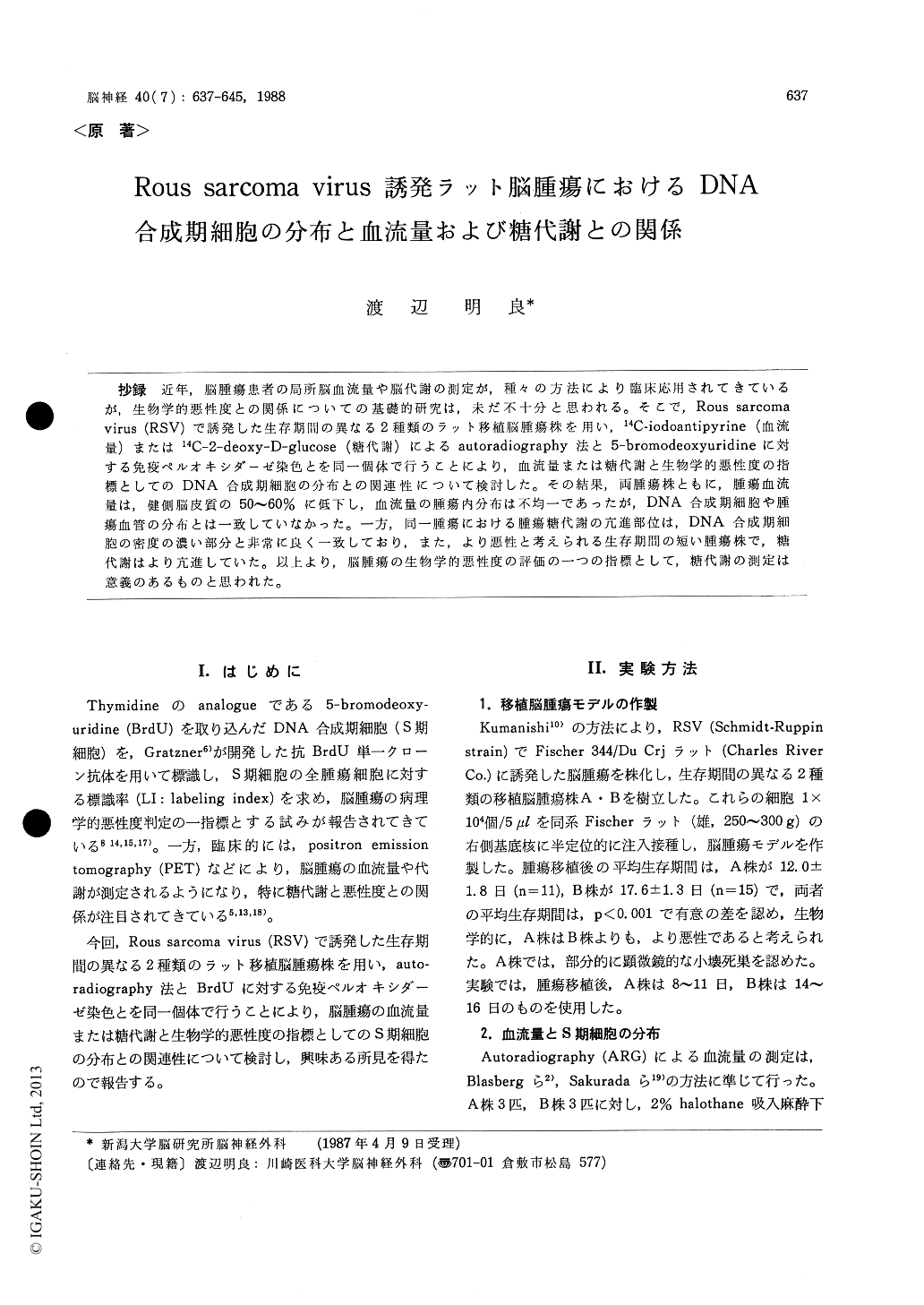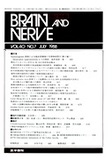Japanese
English
- 有料閲覧
- Abstract 文献概要
- 1ページ目 Look Inside
抄録 近年,脳腫瘍患者の局所脳血流量や脳代謝の測定が,種々の方法により臨床応用されてきているが,生物学的悪性度との関係についての基礎的研究は,未だ不十分と思われる。そこで,Rous sarcomavirus (RSV)で誘発した生存期間の異なる2種類のラット移植脳腫瘍株を用い,14C-iodoantipyrine (血流量)または14C-2-deoxy-D-glucose (糖代謝)によるautoradiography法と5-bromodeoxyuridineに対する免疫ペルオキシダーゼ染色とを同一個体で行うことにより,血流量または糖代謝と生物学的悪性度の指標としてのDNA合成期細胞の分布との関連性について検討した。その結果,両腫瘍株ともに,腫瘍血流量は,健側脳皮質の50〜60%に低下し,血流量の腫瘍内分布は不均一であったが,DNA合成期細胞や腫瘍血管の分布とは一致していなかった。一方,同一腫瘍における腫瘍糖代謝の亢進部位は,DNA合成期細胞の密度の濃い部分と非常に良く一致しており,また,より悪性と考えられる生存期間の短い腫瘍株で,糖代謝はより亢進していた。以上より,脳腫瘍の生物学的悪性度の評価の一つの指標として,糖代謝の測定は意義のあるものと思われた。
The correlations between blood flow or glucose metabolism and distribution of DNA synthesizing cells were simultaneously investigated in the same rat brain tumors using autoradiographic technique and immunoperoxydase stain. Two rat brain tumorstrains (A and B) induced by Rous sarcoma virus were used. A suspension of 1×104 rat brain tumor cells was stereotactically implanted into the right basal ganglia of syngenic Fischer 344/Du Crj rats. The tumor strain A bearing rats died 12.0±1.8 days and the tumor strain B bearing rats died 17.6±1.3 days after the tumor implantation. Blood flow and glucose metabolism were measured with 14C-iodoantipyrine and 14C-2-deoxy-D-glucose autoradiography. All rats also received a 1-h i. v. infusion of BrdU, 5-20 mg, at the autoradiographic procedure. The immunoperoxydase staining for BrdU (Avidin Biotin peroxydase complex method) and other conventional stainings were performed in the sections alternating with the autoradiogra-phic sections. BrdU-positive nuclei (S-phase cells) were heterogeneously distributed and labeling index ranged from less than 1% to more than 40% in the tumors. Neoplastic vessels tended to be distributed in the peripheral part of the tumor and were surrounded with S-phase cells in a part of the tumor. The blood flow was hetero-geneously distributed in the tumor and the average blood flow reduced to about 50% in the tumor strain A and to about 60% in the tumor strain B, respectively in comparison with contralateral cor-tex. The distribution of blood flow did not correlate with the distribution of S-phase cells nor the dis-tribution of neoplastic vessels. The average glu-cose metabolism increased to about 250% (A) and to about 170% (B) in comparison with con-tralateral cortex, respectively. Homogeneous pattern of glucose metabolism was observed in the tumor strain A, and the high metabolism area well cor-related with the distribution of S-phase cells in the tumor strain B. These findings suggest that the biological malignancy of tumor correlates with glu-cose metabolism rather than blood flow. In brain around tumor, blood flow was grossly irregular but glucose metabolism distinctly decreased. In ipsilateral cortex, both blood flow and glucose me-tabolism reduced in comparison with contralateral cortex.

Copyright © 1988, Igaku-Shoin Ltd. All rights reserved.


